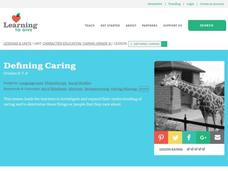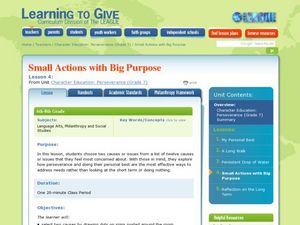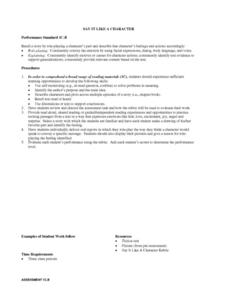US Institute of Peace
Nonverbal Communication
What is your body saying that maybe your words aren't? Scholars explore the vast world of the subtle, and not-so-subtle, nonverbal communication cues through group and individual work. Lesson seven in a series of peacebuilding exercises...
Missouri Department of Elementary
Fly Your Kite
Encourage scholars to become a productive community member with a kite-themed lesson. Following a review and discussion, learners complete a Venn diagram that displays the connection between character traits needed to make a home and...
Missouri Department of Elementary
I’m Thumbody!
Positive and negative thinking is the focus of a lesson that boost self-awareness. Beginning with a whole-class discussion, scholars brainstorm what positive thinking looks and sounds like then compares and contrast the two types of...
Scholastic
Hopes and Dreams
A lesson encourages mini scholars in setting goals. Peers share their hopes and dreams and discuss how each one adds to everyone's unique character. Class members draw themselves in a scene achieving a goal. A follow-up meeting allows...
Overcoming Obstacles
Having a Positive Attitude
Through discussion and reflection, scholars discover what it means to have a positive attitude, that an individual can choose to stay positive, and discuss the benefits of a positive attitude. Learners listen to negative scenarios to...
Health Smart Virginia
Face of Mental Illness
There are a lot of myths and misinformation out there about mental illness. Help set the record straight with a resource that debunks the falsehoods and provides high schoolers with accurate and important information about the various...
Healthy Native Youth
Chapter 7: Revisiting the Circle of Life
Scholars revisit the Circle of Life to examine positive character traits—mental, physical, spiritual, and emotional. Pupils discuss how those character traits could help them make responsible decisions and not contract HIV/AIDS. Learners...
Overcoming Obstacles
Integrity
A lesson plan showcases the character trait of integrity. Scholars define the term, discuss how having integrity means being trustworthy, that one can choose to have integrity, and the significance of looking at situations from other...
Overcoming Obstacles
What Is Overcoming Obstacles?
Just like becoming proficient at playing an instrument or sport requires practice, so too does developing the skills to overcome life's obstacles. That's the big idea in the first lesson in a life skills course. To begin, participants...
Curated OER
Identity, Belonging, and Social Inclusion
Students explore personal and social identity. In this character education instructional activity, students create identity profiles and design welcome plans for their school community in order to build personal and community identities.
Media Literacy
Good Versus Evil: Exploring Popular Children's Animation
Dora, Buzz Lightyear, Mufasa. Swiper, Dr. Porkchop, Scar. The six lessons in this unit packet focus on how good and evil, and violence, are portrayed in children's animation. The lessons encourage kids to consider how violence is...
Curated OER
Defining Caring
Eighth graders define caring. In this character education lesson plan, 8th graders examine the attributes of compassion as they discuss altruism, empathy, and selflessness.
Curated OER
Belonging
Students examine their personal feelings regarding exclusive groups. In this character education lesson, students conduct mini-debates as they discuss how they relate to one another regarding exclusive social groups.
Curated OER
Small Actions with Big Purpose
Seventh graders examine the trait of perseverance. For this character education lesson, 7th graders discuss community causes they care about and make plans to contribute their time and energy to overcome their personally-selected issues.
Curated OER
Personality Poems
Students create a bio-poem for themselves or characters in stories they have read. They explore common character traits.
Curated OER
Communicating Feelings
Students demonstrate ways to communicate feelings. In this character education lesson, students talk about communication and are shown examples of faces showing different emotions. Students identify the emotion and practice communicating...
Curated OER
Spookley the Square Pumpkin
Students complete activities with the story Spookley the Square Pumpkin. In this holiday lesson, students listen to the story and create their own Spookley pumpkin with Popsicle sticks and paints. They use their character counts traits...
Curated OER
Puppet Frogs
Learners identify the elements of line, shape, and color and expressive qualities of pictorial representation. Students create their own puppet frog using emotion and perform in a reader's theater. Learners listen to various pieces of...
Curated OER
Character Education Courage
Students listen to a Mariah Carey song and chose words that explain courage. In this courage lesson, students explore the traits that make a hero. Students pair share what traits make someone a hero and then discuss their results with...
Curated OER
Goals and Perseverance
Define the word perseverance to have learners understand why it is important in reaching goals. Young scholars research how Martin Luther King needed perseverance to accomplish his goals. They write acrostic poems using the word...
Curated OER
Unique Monique: Building a Community of Unique Individuals
Young scholars recognize that each student is unique and has special talents. Students develop a puzzle piece that describes them and their particular talents. Young scholars share their pieces and post on a bulletin board.
Curated OER
How We Feel
Students examine how their feelings make them unique. They read and discuss a poem, develop a list of feelings, and create a drawing of them feeling happy and healthy.
Curated OER
Our Successful Traits
Young scholars brainstorm and discuss essential traits for success. They develop a group list that displays essential traits of the successful classroom and journal about the experience.
Curated OER
Say It Like A Character
Young scholars read a story and retell it to the class by role-playing one of the characters. In groups, they use the correct facial expressions along with body language and voice to convince the others in their group that they are...

























